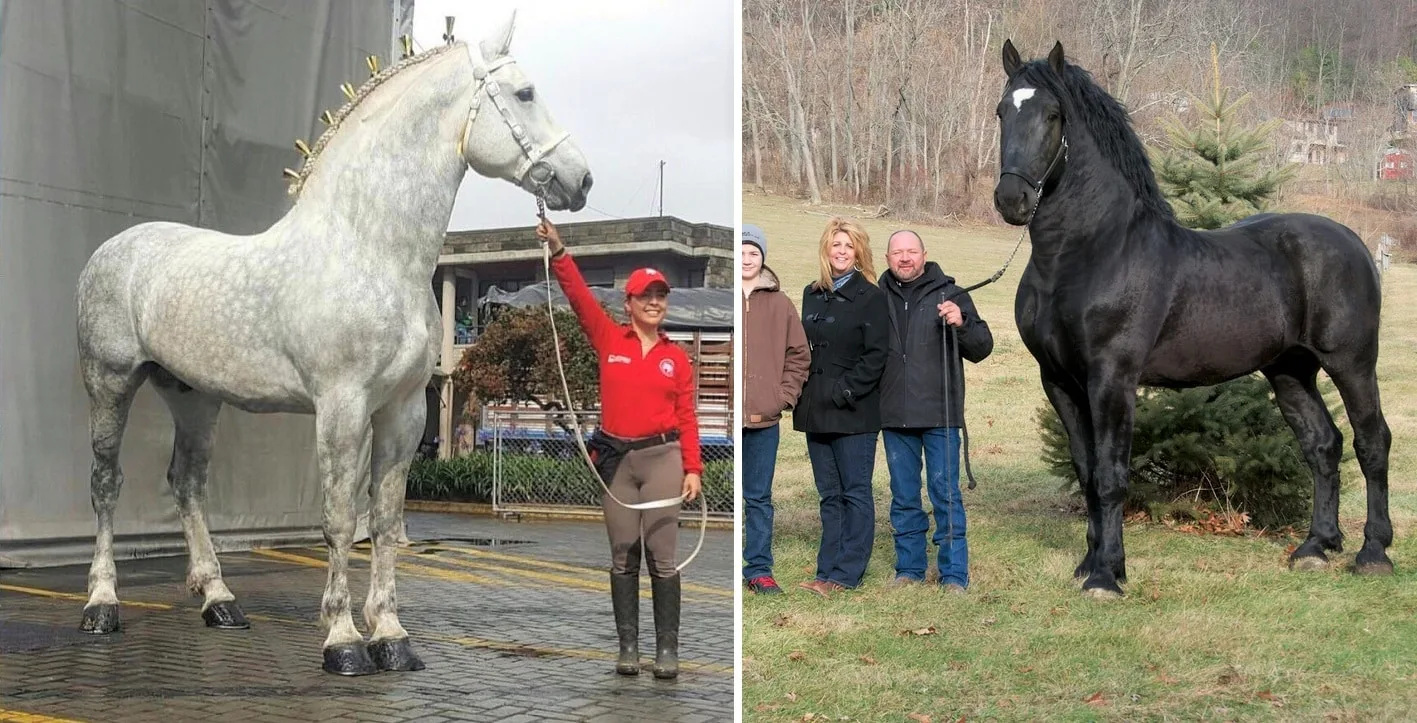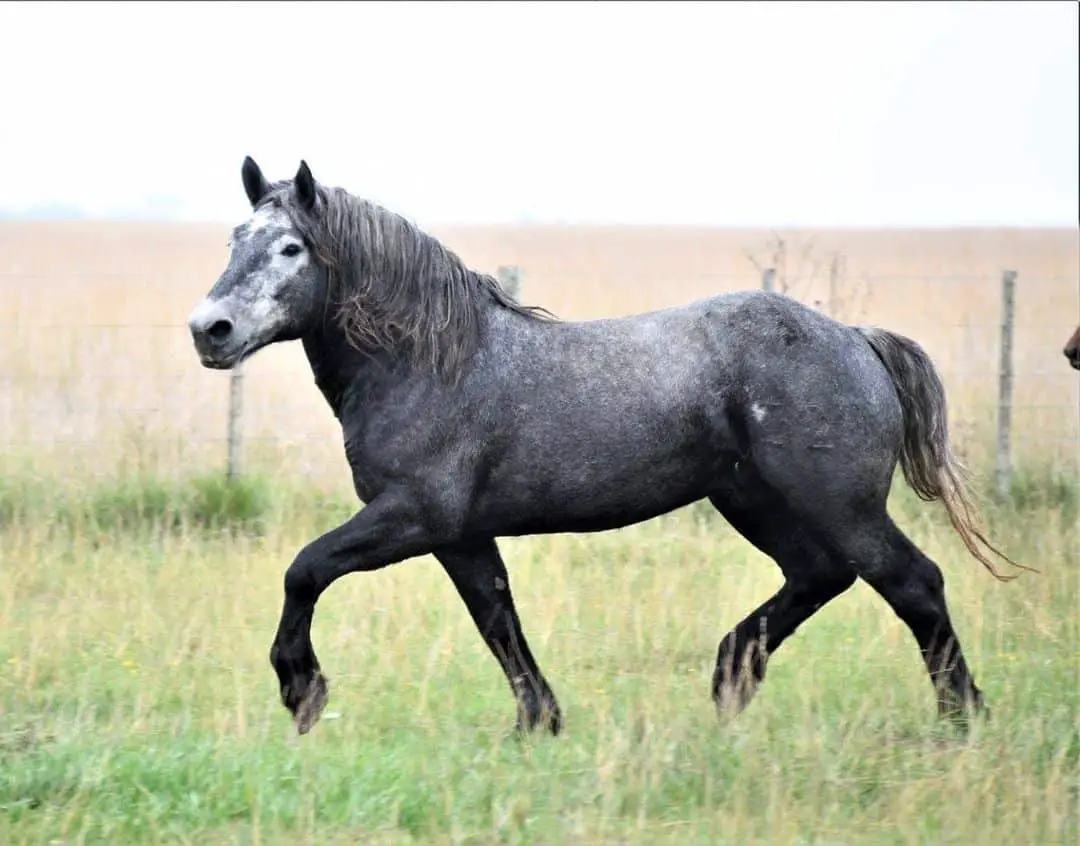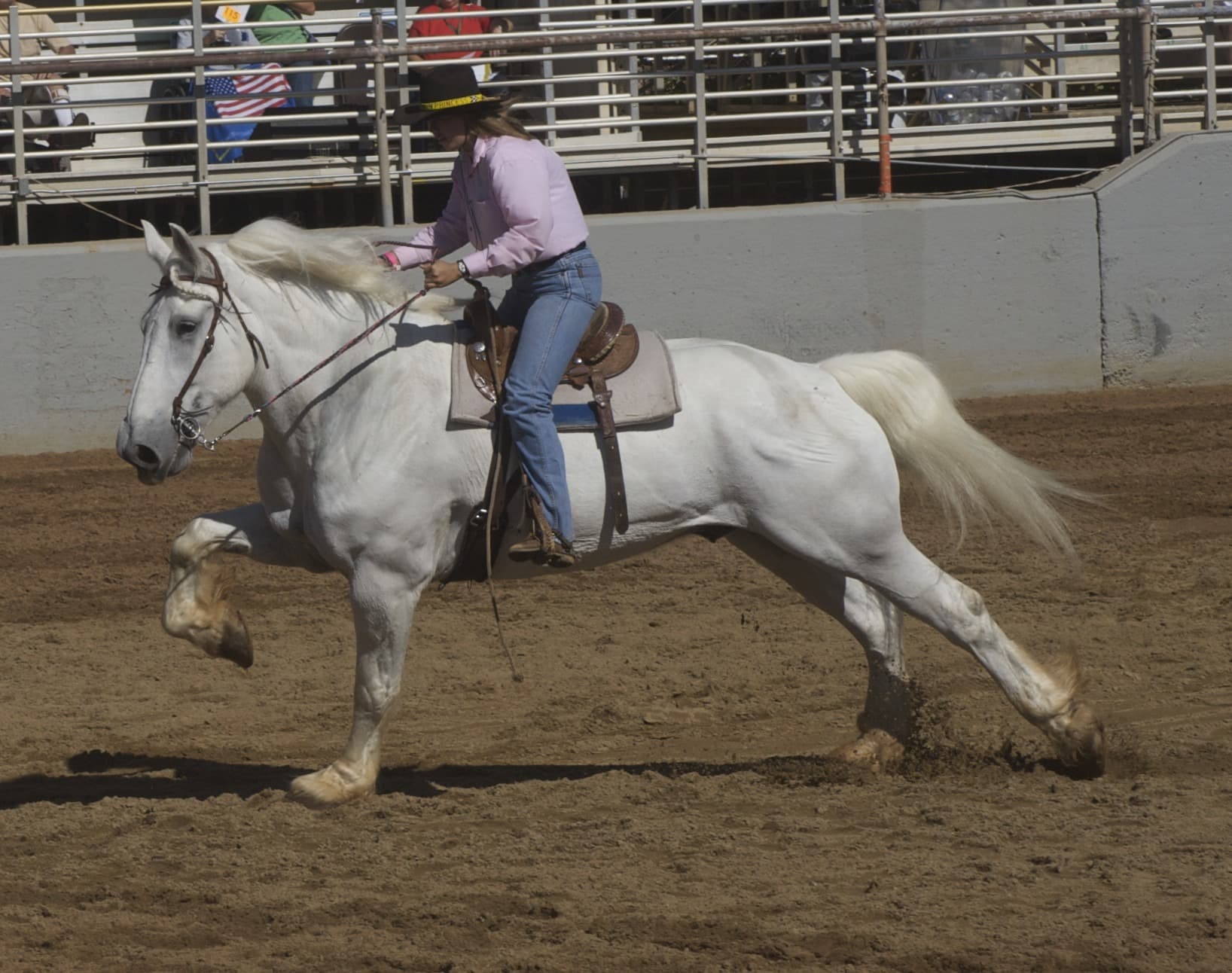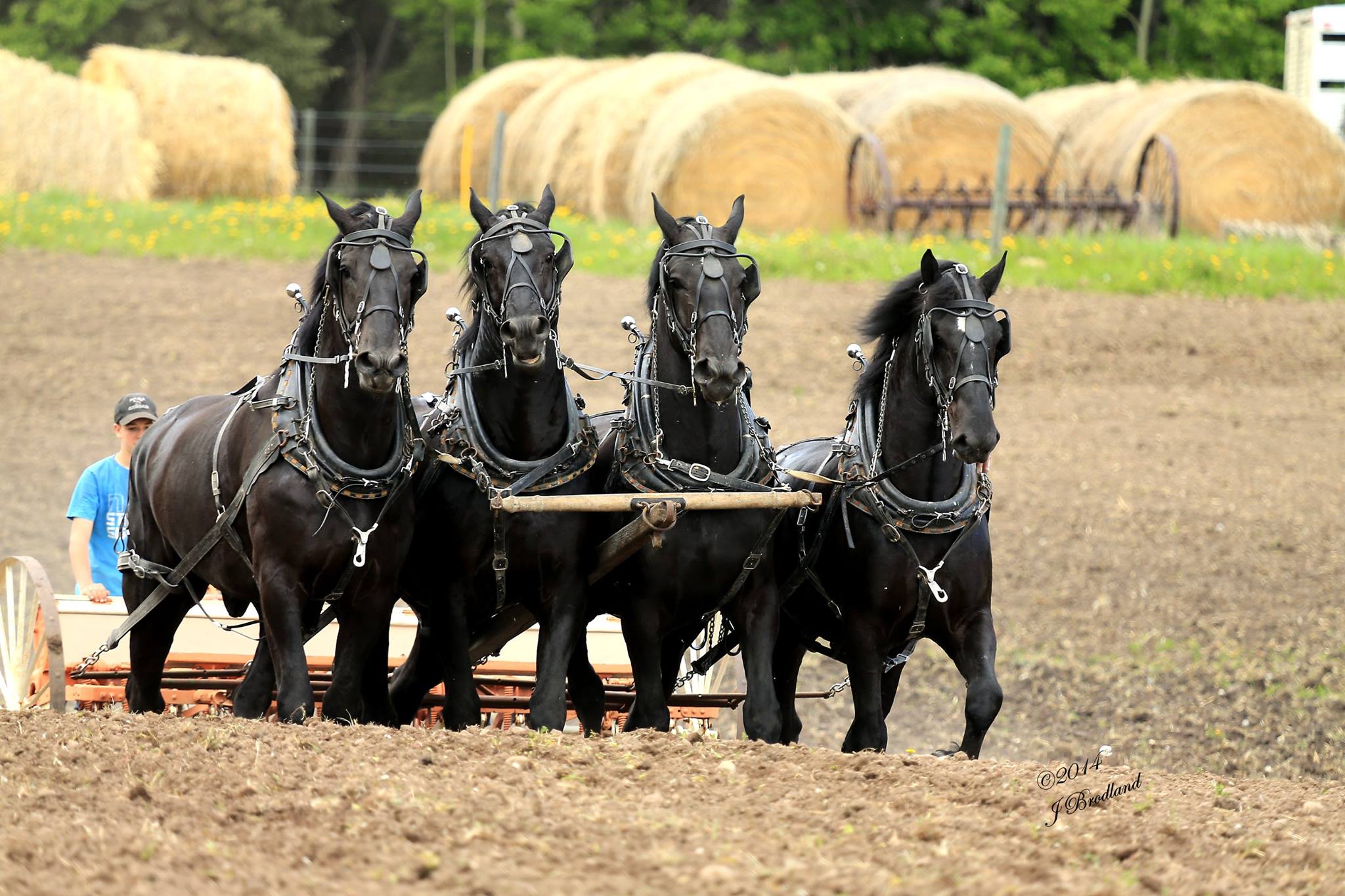Standing tall with a noble presence, Percheron horses are a breed that commands respect. Known for their versatility and strength, these equine giants have served humans for centuries, adapting to our evolving needs. In this blog post, we delve into the many roles and responsibilities that have been traditionally and are currently assigned to this majestic breed.
Exploring the Legacy and Traits of Percheron Horses

The Percheron breed, with its striking combination of elegance and muscle, has a storied past stretching back to its French roots. Their adaptability and strong constitution have allowed them to transition seamlessly through various historical roles to today’s diverse applications, underlining their significant place in horse heritage. We will explore the remarkable journey and attributes that make the Percheron such a respected member of the equine family.
Historical Significance and Evolution
This breed’s historical narrative intertwines with the evolution of society, where they have been integral in shaping farming advancements and facilitating commerce. Their genetic heritage, enriched by a blend of local Perche stock and Arabian influence, has endowed them with remarkable endurance and flexibility. The breed has been shaped by the requirements of successive ages, from the battlefield to the fields of agriculture.
Visual and Physical Hallmarks
When examining the Percheron’s physique, one cannot help but admire their robust conformation. Attributes such as:
- Broad backs and muscular loins
- Substantial legs with strong bone structure
- Refined heads with an alert expression
distinguish them from other breeds. Their coats, primarily in hues of gray or black, are occasionally adorned with other colors, contributing to their aesthetic distinction. The Percheron’s grandeur is further accentuated by its luxurious mane and tail, which complement its regal bearing.
Modern Contributions and Adaptations
The Percheron has adeptly adjusted from its role in conflict to becoming an invaluable partner in peacetime endeavors. Its reach extended from France to North America during the 19th century, enhancing agricultural practices and urban transportation. Today, the breed retains the admirable qualities of its ancestors, emblematic of historical depth and practical relevance.
Psychological and Behavioral Traits
Further exploring the Percheron’s attributes, their psychological characteristics are as noteworthy as their physical ones. Known for their even-tempered nature and sharp intelligence, they are favored by horse lovers for a variety of activities. These mental traits enhance the breed’s versatility, allowing them to perform in different equestrian disciplines and serve in therapeutic settings, where they provide assistance and comfort.
Conservation and Contemporary Breeding Efforts
Ensuring the continuity of the Percheron’s distinct genetic traits is a focus for breed enthusiasts. Through meticulous record-keeping and breeding practices that meet stringent criteria, the integrity of the Percheron bloodlines is preserved. Current breeding efforts aim to perpetuate the most desirable qualities of the breed, while also prioritizing genetic health and variation.
The Percheron horse remains an irreplaceable element of our cultural history. With their compelling background and multifaceted skills, they continue to enchant and fulfill various roles for humankind, from heavy labor to forming bonds of companionship. The legacy of the Percheron sets a foundation for their ongoing significance in societies worldwide.
Percheron Horses: A Continued Legacy in Modern Roles

The Percheron horse remains a dynamic participant in contemporary society, demonstrating a breadth of utility that spans across various domains. These equines are more than historical icons; they actively engage in modern-day activities that enhance our agricultural, recreational, and urban environments. The following sections highlight the Percheron’s current applications and their ongoing relevance across different areas of human endeavor.
Percheron Horses in Organic and Eco-Sensitive Ventures
Percherons have a pivotal role in environmentally conscious agricultural and forestry projects, where their formidable strength is a valuable asset. They are integral to:
- Organic farming systems that favor natural over mechanical processes
- Sustainable logging operations where their use minimizes ecological impact
- Conservation efforts that seek to maintain traditional agricultural methods
These horses are essential allies in practices where ecological preservation is paramount.
Recreational and Show Use of Percherons
Beyond their work-related capabilities, Percherons captivate audiences in the spheres of leisure and public display. They are featured in:
- Competitive equestrian sports and showcase events
- Recreational riding programs suitable for various skill levels
- Cultural and festive parades, lending their majestic presence
Their amiable nature and trainable disposition make them ideal for engagements that require both strength and elegance.
The Percheron’s Role in Learning and Healing
Percherons also make significant contributions to educational and therapeutic initiatives. Their keen intelligence and calm temperament allow them to be part of:
- Interactive equine-assisted education programs
- Specialized therapeutic riding to aid individuals with diverse needs
- Instructional activities for novice horse enthusiasts
These horses foster personal development and provide support in restorative practices.
Percherons Enhancing Urban Life
In urban landscapes, Percherons offer a touch of nature and tradition. They enrich city life through:
- Charming carriage services that offer a nostalgic touch to city tours
- Mounted patrols where horses are preferred for their crowd-friendly nature
- Educational outreach by serving as live exhibits in metropolitan farm settings
These contributions highlight the Percheron’s adaptability and the value they bring to modern urban communities.
The extensive uses of Percheron horses today mirror their versatility and affirm the lasting esteem in which they are held. From pastoral landscapes to the heart of the city, therapeutic spaces to ceremonial events, Percherons prove time and again that their capabilities are deeply ingrained in the fabric of contemporary life.
Further Insights into the Roles of Percheron Horses

The Percheron horse, with its impressive stature and adaptability, has a rich history of evolution from military use to peaceful activities. Their roles have expanded, reflecting their remarkable flexibility and the enduring bond they maintain with humans. The multifaceted nature of the Percheron breed purposes demonstrates their ability to adapt from their noble beginnings to the varied demands of the present day, showcasing a continuous tapestry of service and companionship.
Transition from War to Agriculture
Originating from the Perche province in France, Percherons have a lineage that boasts both valor in war and diligence in work. As the age of armored knights ended, these horses found their place within the agricultural domain, providing essential services in rural economies, including transportation and heavy plowing. Their transition from warhorses to farm horses marks a significant shift in their historical roles.
Contemporary Celebratory and Public Roles
In modern settings, Percherons are prized for their gentle demeanor and impressive stature, making them suitable for a variety of public and celebratory functions. They contribute to the elegance of special occasions and are a favorite for their ability to engage comfortably with people during various events and festivities.
Percherons on Screen and Stage
The entertainment industry values Percherons for their majestic appearance and composed nature. They are often featured in settings that require a commanding equine presence, including historical reenactments and live-action performances, where they execute complex sequences with grace.
Percherons in Sustainable Agriculture
Embracing the trend of sustainable agriculture, Percherons are becoming integral to practices like viticulture. In vineyards, they assist with soil management and careful cultivation, proving their value in precision-intensive tasks and eco-friendly farming methods.
Percherons in Ecosystem Management
These versatile horses also partake in conservation grazing, where they help manage ecosystems by controlling invasive plant species. This selective grazing promotes biodiversity and reduces the risk of wildfires, showcasing Percherons as a sustainable solution for environmental management.
Throughout their history, Percherons have shown an exceptional ability to adapt and serve in various capacities. Their presence enriches vineyards, urban landscapes, and ceremonial occasions alike, reinforcing their status as a breed of versatility and resilience. Their legacy continues to evolve with each new role they undertake, solidifying their place in our present-day society.
Understanding Percheron Horse Behavior

Appreciating the behavior of the Percheron horse is crucial for those who interact with this distinguished breed. Exhibiting a stable and cooperative nature, these horses are particularly known for their calm and docile temperament, which greatly influences their relationships with people. We’ll delve into the behavioral characteristics that make Percheron horses such valued companions and workers, highlighting their serene nature and its impact on their interactions with humans.
Behavioral Characteristics of Percheron Horses
Percherons are often celebrated for their tranquil and amiable nature. Notable behavioral characteristics include:
- Forbearance: Their exceptional patience is advantageous, especially when they’re involved in educational programs or when working with novices.
- Sociability: Their genial disposition enables them to establish meaningful relationships with humans and other animals.
- Flexibility: They display an impressive capacity to adjust to new circumstances and assignments, underscoring their versatility.
Such traits underscore their reputation as dependable and multifaceted equines, well-suited to a range of equestrian pursuits.
Work Disposition of Percherons
The work disposition of Percherons reflects a commendable aspect of their behavior. They embrace their duties with a cooperative spirit, characterized by:
- Commitment: A sense of responsibility and a commitment to their work.
- Stamina: Their capability to maintain effort over extended durations, which is indispensable in various labor-intensive roles.
- Concentration: An aptitude for learning swiftly and performing tasks with consistency.
These qualities, coupled with their stature and strength, render the Percheron an unwavering ally in a wide array of endeavors.
Cognitive Aptitude and Receptiveness of Percherons
The perceptiveness and receptiveness of Percherons are also integral to their behavior. They are keenly aware of their environment and sensitive to the guidance of their handlers, evident in:
- Intuition: Their capacity to often intuit the intentions of their handlers, enhancing their responsiveness to training.
- Emotional acuity: Their attunement to human emotions plays a crucial role in therapeutic contexts.
- Composure: Their ability to remain calm under duress is why they are preferred for roles in public events and ceremonies.
The synthesis of these attributes allows Percherons to execute a diverse range of tasks with finesse and poise.
Forming Bonds with Percherons
The process of establishing bonds with Percherons is greatly influenced by their affable and intelligent nature. Their openness to interaction and cognitive abilities create a foundation for a reciprocal relationship steeped in respect and comprehension. This connection elevates them from the status of mere laborers to that of companions, fostering a harmonious and efficient partnership. Interactions with Percherons can be incredibly fulfilling, as their inviting temperament fosters a level of engagement that transcends standard working relationships.
To conclude, the Percheron horse’s behavior reflects a distinctive combination of mildness, astuteness, and cooperative spirit. These attributes play a significant role in the breed’s aptitude for various applications, from strenuous labor to therapeutic engagements. Their behavioral adaptability and resilient spirit are instrumental in ensuring that Percherons continue to be a beloved breed, treasured for their psychological qualities as much as their physical attributes.
Heavy Horses in Focus: Percheron and Clydesdale Attributes

Heavy horses possess unique characteristics that make them suited for various roles, with the Percheron and Clydesdale being among the most distinguished. This examination of Percheron vs Clydesdale will highlight the distinct qualities and specializations of these two breeds without repeating the detailed history and roles covered in the preceding text.
Distinguishing Physical Traits
Percherons and Clydesdales, both symbols of strength, differ subtly in their structure and aesthetics:
- Percherons present a more densely muscled build ideal for demanding tasks, whereas Clydesdales exhibit a more elongated frame with a high stepping gait, offering both functionality and showmanship.
- Clydesdales feature prominent feathering on their legs, which enhances their flair, particularly in public exhibitions. Percherons, in contrast, have less feathering, a trait that can be practical in various working conditions.
- While Percherons generally showcase grey or black coats, Clydesdales are often bay with distinctive white facial and leg markings, contributing to their immediate recognition.
Nature and Learning Aptitude
The temperaments of Percherons and Clydesdales showcase their affability, with some nuances:
- Percherons are appreciated for their serene and cooperative demeanor, qualities that facilitate training and effectiveness in equine-assisted programs.
- Clydesdales, with their amiable and outgoing personalities, are adept at engaging onlookers, demonstrating their ability to quickly assimilate new skills in various settings.
Versatility in Contemporary Roles
These breeds continue to excel in diverse modern applications:
- Percherons are increasingly involved in therapeutic and leisure riding, showcasing their docile temperament beyond traditional labor.
- Clydesdales have evolved to become emblems of cultural celebration, their attention-grabbing appearance has made them a favorite for promotional endeavors and ceremonial duties.
Choosing between a Percheron and a Clydesdale involves considering their physical and temperamental traits, along with their adaptability to today’s demands. Both breeds possess enduring qualities of power, elegance, and devotion, endearing them to horse enthusiasts globally.
Optimal Management for Percheron Horse Well-being

Caring for Percheron horses goes beyond basic needs, focusing on specialized requirements due to their draft nature. These horses must have a diet that sustains their large build and energy demands, thorough grooming for coat health, and health care that addresses the unique concerns of larger breeds. Fostering their long-term health and contentment hinges on a comprehensive care strategy.
Feeding Requirements for Optimal Health
Percheron horses thrive on a diet that provides sufficient nutrition to support their considerable size and energy needs. Essential aspects of their diet include:
- Quality forage that allows for natural grazing behavior and promotes digestive well-being.
- Grain intake proportionate to their exertion levels to avert health complications from overfeeding.
- Vitamins and minerals to supplement their diet, particularly when forage alone does not meet their nutritional needs.
- Continuous access to water to aid in digestion and overall hydration.
Working with a professional in equine nutrition can help tailor a dietary regimen that suits the Percheron’s dynamic lifestyle while addressing potential metabolic concerns.
Essential Grooming Practices
Consistent grooming is vital for maintaining the health and magnificence of Percheron horses. A diligent grooming routine can involve:
- Regular brushing to enhance coat health and prevent skin issues.
- Proper hoof maintenance to support their substantial weight and prevent hoof-related ailments.
- Care for their mane and tail to keep them free of knots and minimize the risk of skin problems.
Through attentive grooming, caregivers can not only ensure the horse’s welfare but also strengthen their connection with these noble animals.
Proactive Health Maintenance
Proactive health management is essential in safeguarding the wellness of Percherons. Owners should be vigilant in:
- Identifying early signs of laminitis and seeking prompt treatment to mitigate its effects.
- Recognizing and managing arthritis, which is prevalent in heavy breeds, through veterinary care and suitable management strategies.
- Keeping up with preventative measures like vaccinations and parasite control.
- Maintaining an exercise program that promotes joint mobility and cardiovascular health.
Regular veterinary check-ups are critical to prevent health issues and to customize a preventative care regimen for Percherons.
Training and Exercise Essentials
Percheron horses benefit from a well-planned exercise routine that considers their size and capacity. Their physical regimen should incorporate:
- Gradually escalating exercise to build stamina without causing harm.
- Diverse training that combines cardiovascular and strength exercises for a balanced fitness approach.
- Sufficient time in a secure area for natural behaviors and interaction with other horses.
Training should capitalize on the Percheron’s intellectual and cooperative temperament to foster positive training experiences.
Accommodating Percheron Space Requirements
Living spaces for Percherons should be tailored to their significant size and need for comfort. Essential considerations for their accommodation include:
- Roomy enclosures that allow them to move and rest comfortably, with bedding to cushion their weight.
- Robust barriers to ensure safety during outdoor activities.
- Protection from harsh weather, with shaded areas in warm seasons and warm shelters when it’s cold.
Providing a suitable living environment is crucial for the wellbeing of Percherons, enabling them to prosper in human care.
Are you curious about the various roles that different horse breeds play? While you’re exploring the uses of Percheron horses, you might also be interested in other breeds and their purposes. Dive into our articles that detail what Hanoverian horses are used for, uncover the specialties of Arabian horses, and learn about the unique gait of the Paso Fino horses. Each breed has a rich history and a set of characteristics that make them suitable for a variety of activities, just like the mighty Percheron.
Conclusion
In conclusion, the Percheron horse is a versatile and valuable breed with a storied history and a bright future.
Choosing a Percheron: Is It Right for You?
Choosing a Percheron requires consideration of their size, needs, and the tasks at hand. They are ideal for those seeking a gentle giant with a cooperative spirit for work, recreation, or companionship.
Preserving the Breed: The Future of Percherons
Preserving the breed is essential. Enthusiasts and breeders alike must continue to advocate for Percherons, ensuring they remain an integral part of our shared heritage and continue to thrive for generations to come.



